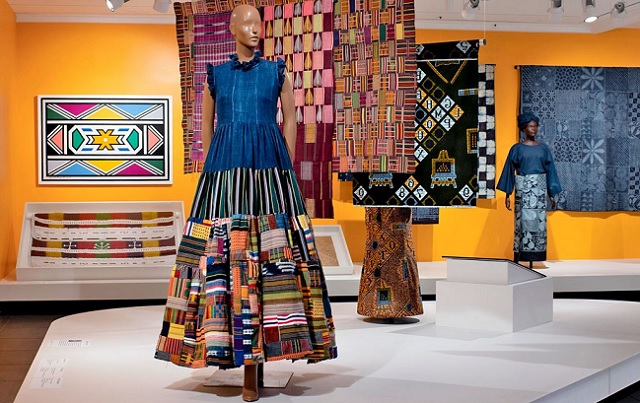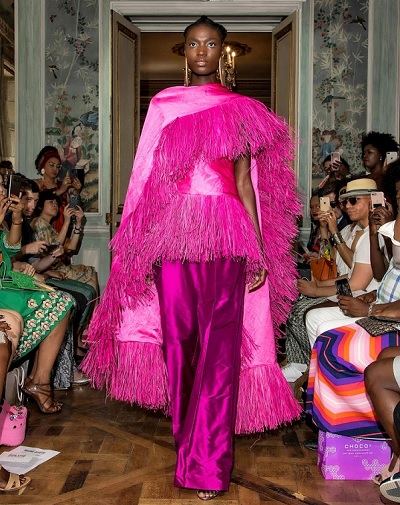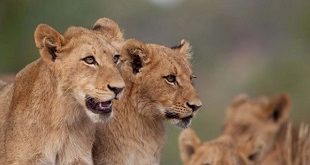
Co-curator Ernestine White-Mifetu gives us an illuminating tour of “Africa Fashion” and the greater narrative it encapsulates.
ART | LEE CARTER | At the Brooklyn Museum, an electrifying new exhibition establishes Africa as a true fashion capital, bursting with imagination, ingenuity, and its own aesthetic heritage. “African Fashion” showcases the designers and other creatives leading the continent’s charge into the 21st century.
Yet the exhibition, which runs through October 22, is much more than a wondrous fantasia of eye-popping looks on mannequins. By highlighting key pieces from designers, artists, and artisans from the mid-20th century onward, it illuminates a panoply of artistic visions to come out of Africa and its diaspora, laying the fascinating historical groundwork for today’s stylistic revolution.
It has been a century since the Brooklyn Museum became the first arts institution to showcase African art to a North American audience, making it an ideal spot for curators Ernestine White-Mifetu and Annissa Malvoisin to assemble over 300 objects, encompassing not only fashion and textiles, but jewelry, art, photography, and video, as well as vintage posters, magazine covers, and other ephemera. The museum has also partnered with the Brooklyn Public Library to make copies of the historic books on display in the show available to check out. It is, according to the museum, the largest presentation of its kind ever installed in a North American venue.
“Africa Fashion” launched at the Victoria and Albert Museum in London in 2022, although it has benefited greatly from its expedition to Brooklyn. As co-curator Ernestine White-Mifetu explained during a tour, “It was important that we insert the narratives of creatives here in North America.” Curator of African art at the museum, she and her colleagues adapted the show for the fresh audience, integrating it in its new surroundings and supplementing it with works from the museum’s own holdings one of the largest collections of African art in the U.S. The result is a special blend of African and diasporic identity with American flair.
The show includes, for instance, works by two Brooklyn-based designers who are making a serious splash, Aurora James and Christopher John Rogers. Owing to her Africa-inspired designs, as well as her 15 Percent Pledge initiative that urges fashion retailers to devote at least 15 percent of their shelf space to Black-owned businesses, James was featured on the cover of Vogue a painted portrait by Jordan Casteel in 2020. At 24 years old, Rogers earned the top prize at the CFDA/Vogue Fashion Fund the year after he debuted his collection in 2018.
The show begins at the end the end of colonial rule in Africa. Morocco and Tunisia liberated themselves from French authority in 1956. Ghana wrested itself from Britain a year later. Coined the Year of Africa, 1960 saw 17 other African nations shake off colonialism. That number had reached 48 by the end of the decade. Those independence movements, each unique and momentous, led to radical self-reinvention an awakening that launched a cultural renaissance reverberating throughout the arts. Importantly, creatives drew on formerly marginalized traditions to create wholly new and innovative forms.

It was a volatile yet vibrant time that, in many ways, could not have happened without a series of festivals known as FESTAC. The first took place in 1966 in Dakar, Senegal, and the last in Lagos, Nigeria, in 1977. As illustrated in “Africa Fashion,” the month-long festivals hosted artists, writers, performers, and musicians from across the continent and beyond. As many as 15,000 participants from nearly every African nation 54 at the time plus the diaspora came together to galvanize pan-African unity through the arts, making it the largest cultural event ever held on African soil.
“You see Langston Hughes and you see Duke Ellington traveling to FESTAC in 1966, and Stevie Wonder and Alvin Ailey in 1977,” explained White-Mifetu. South African singer and anti-apartheid activist Miriam Makeba, known as Mama Africa, was another notable attendee in 1977. “It was a large-scale celebration of the Black and brown body and its entire scope of creativity.”
That is the sanguine context in which we find the first group of garments. “As the continent emancipated itself, artists were using fabric as a visual language to engage with the new and hopeful political landscape,” said White-Mifetu.
She nodded to a display of commemorative cloths, used to observe important political events. The last of these bears an image of Nelson Mandela upon becoming president of the African National Congress of South Africa in 1991, juxtaposed with a more contemporary print by New York-based Nigerian designer Lola Faturoti, who, working in the tradition of commemorative cloths, chose to celebrate the presidential inauguration of Barack Obama in 2008.
The next section speaks to the wealth of textile traditions across the continent silk kente, raffia-woven kuba, indigo-dyed àdìrẹ, strip-woven aṣọ-òkè, and mud-painted bògòlanfini, to name just a few Another Time (2011) take inspiration from Ghana’s kente tradition, and the geometric patterns painted on canvas by South African artist Esther Mahlangu draw from the visual lexicon of her Ndebele heritage. “And of course,” said White-Mifetu, “we couldn’t not include a contemporary Yinka Shoniba sculpture in this dialogue around the influence of textiles and their histories.”
Out of this crackling frisson emerged a group of dressmakers and tailors who found themselves transformed into modern 20th-century fashion designers. Five of them are spotlighted here: Chris Seydou (Mali), Kofi Ansah (Ghana), Naïma Bennis (Morocco), Alphadi (Mauritania), and Shade Thomas-Fahm (Nigeria). Many of the garments on display are intriguing hybrids of African and Western styles as designers began to look outward. We see this in the work of Thomas-Fahm, the first designer to open a store in Nigeria following a trip to Britain, where she discovered the designer boutique. She sought to modernize her customers by fashioning head wraps with snaps in them, as well as wrapped skirts with built-in zippers. “She was designing for the modern young woman who didn’t have time for all that draping, wrapping, and assembling,” said White-Mifetu. “In a post-independence world, women were much more mobile and on the go.”
One of the more poignant parts of the show is an area devoted to photography, which has played an outsized role in African life since the invention of the camera. “We wanted to show the importance of the camera in the articulation of style by individuals newly free to imagine, dress, and interpret their identity,” said White-Mifetu. Two stylized fashion photographs by Senegalese artist Omar Victor Diop appear to expand on the portraiture of Malian photographers Seydou Keïta and Malick Sidibé in the 1960s and ‘70s, which then lead through a corridor to the work of Brooklyn-based Kwame Braithwaite, a Guggenheim Fellow and influential figure in the ‘Black is beautiful’ movement.
The colorfully framed, provocative photographs of Hassan Hajjaj are also included. The Moroccan artist found a degree of international popularity with a 2010 series called “Kesh Angels,” in which veiled and covered women but also wearing heart-shaped sunglasses and striped socks sat on stationary motorbikes in front of the Theatre Royal in Marrakesh.
The denouement of the exhibition, a final showcase of contemporary looks made in the spirit of the avant-garde, most successfully underscores the notion that African fashion today is a grand synthesis of communities and influences. The centerpiece is a one-off burqa by Artsi Ifrach for Maison ArtC, made in diaphanous crinoline in the style of a trench coat, a European concept. The Moroccan designer further covered it with embroidered hands, an “Islamic representation of belief,” according to White-Mifetu. In this section, too, we see the Alchemy collection from the popular South African designer Thebe Magugu, who rose to prominence as the winner of the LVMH Young Fashion Designer Prize in 2019 for his explorations of African spirituality and ancestral relationships.
“I hope that the exhibition challenges viewers’ perceptions of African fashion,” said White-Mifetu. “Whether it’s through visual art, music, or fashion, Africa’s contribution to the global conversation is rich and longstanding.
*****
Source: https://news.artnet.com
 The Independent Uganda: You get the Truth we Pay the Price
The Independent Uganda: You get the Truth we Pay the Price



